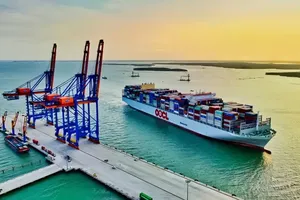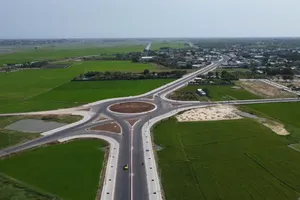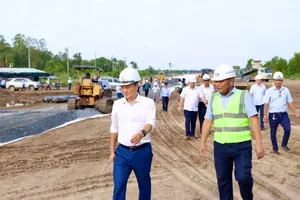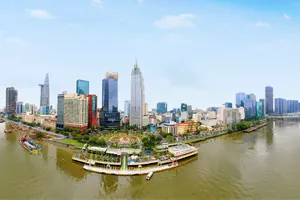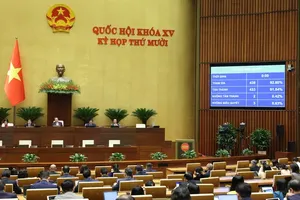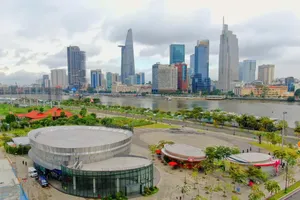 A train passing Nha Trang City in Khanh Hoa Province. (Photo: SGGP)
A train passing Nha Trang City in Khanh Hoa Province. (Photo: SGGP)
* Mr. Vo Van Minh, Chairman of Binh Duong Provincial People's Committee: The Ho Chi Minh City - Loc Ninh railway should be built soon
 Mr. Vo Van Minh, Chairman of Binh Duong Provincial People's Committee. (Photo: SGGP)
Mr. Vo Van Minh, Chairman of Binh Duong Provincial People's Committee. (Photo: SGGP)
Binh Duong Province is an industrial province, so the annual demand for freight transportation is huge. However, the road system is already overloaded, so it is essential to have a railway to reduce the load. Specifically, the HCMC - Loc Ninh railway will be a strategic route, connecting the Central Highlands provinces with Binh Phuoc, Binh Duong, and HCMC with major airports and seaports in the region. The early implementation of this railway route will help provinces in the Southeast region and the Central Highlands improve competitiveness, lower logistics costs, reduce road traffic overload, facilitate the trade of goods effectively, and help to expand cargo and passenger connections with Cambodia. Over the past time, Binh Duong Province has worked with the Ministry of Transport to determine the direction of the Di An - Loc Ninh railway route and continued to coordinate with central ministries and departments to carry out the next steps of the project. The HCMC - Loc Ninh route project, with a length of 129km, including 17 stations passing through Binh Duong and Binh Phuoc provinces, has completed a feasibility study report.* Mr. Nguyen Xuan Hoa, former Chairman of the Board of Directors of the Saigon Railway Joint Stock Company: Connecting seaports and airports starting from HCMC
 Mr. Nguyen Xuan Hoa, former Chairman of the Board of Directors of the Saigon Railway Joint Stock Company. (Photo: SGGP)
Mr. Nguyen Xuan Hoa, former Chairman of the Board of Directors of the Saigon Railway Joint Stock Company. (Photo: SGGP)
The recently announced railway network planning has proposed to restore and build some railway lines in the Southern region with HCMC as the center, including the HCMC - Can Tho railway line, which might be expanded to Ca Mau Province in the future. These projects need to be carried out quickly to solve the problem of overload and high logistics costs for the whole Southern region.
Along with that, priority should be given to building railways connecting HCMC with major traffic hubs, such as airports and seaports, to maximize the efficiency of various modes of transport. They include the HCMC - Loc Ninh (Tay Ninh Province), Thu Thiem (HCMC) - Long Thanh Airport (Dong Nai Province), and Bien Hoa (Dong Nai Province) - Ba Ria Vung Tau routes to connect seaports in the region.
To do this, it is necessary to publish the master plan of the railway network on both main and branch lines soon, thereby making land-use planning for railway development, especially land funds at hub stations. The land fund should be allocated to localities where the railway passes through to manage and preside over site clearance when the railway construction starts. When building new routes through localities, it is necessary to identify the regional station as the hub connecting railways with roads, seaports, and airports.
As the socialization of investment capital in railway infrastructure construction is difficult, it is necessary to legislate the leading role of the State in railway infrastructure investment. It is necessary to base on the effectiveness of railway development brought in all fields of national security, economy, society, and culture, to have mechanisms and policies for tax and fee collection and payback period. If only based on ticket prices and transportation charges alone, it is not a problem of macro investment to build railways. We should encourage the strengths of the localities where the railway passes, create a mechanism to maximize local resources, and create conditions for localities to participate in as the representatives of investors to best mobilize local resources.
The State should pay more attention to using development policies and strategies as leverage for localities. It is necessary to invest in the North-South high-speed railway, but it can only really promote its effectiveness when being invested synchronously throughout the route from infrastructures to vehicles, with connections at major hub stations. Building each railway section will not be effective because, currently, the whole railway line is using the track gauge of one meter while the new track is 1.435 meters.
Investment in railway development must clearly determine the goal of operating both passenger and freight trains. In which, the biggest advantage must be the freight train to contribute to payback, reduce logistics costs, help to improve the goal of ensuring traffic safety and sustainable development, instead of only focusing on passenger transport. It is probably also a poignant lesson of the railway industry over the past years. Investment should be prioritized in the following order: the HCMC - Can Tho, the HCMC - Nha Trang, the Hanoi - Vinh, or Hanoi - Da Nang routes.
* Dr. Vu Dinh Anh, economic expert: Need to get people's opinions
Along with that, priority should be given to building railways connecting HCMC with major traffic hubs, such as airports and seaports, to maximize the efficiency of various modes of transport. They include the HCMC - Loc Ninh (Tay Ninh Province), Thu Thiem (HCMC) - Long Thanh Airport (Dong Nai Province), and Bien Hoa (Dong Nai Province) - Ba Ria Vung Tau routes to connect seaports in the region.
To do this, it is necessary to publish the master plan of the railway network on both main and branch lines soon, thereby making land-use planning for railway development, especially land funds at hub stations. The land fund should be allocated to localities where the railway passes through to manage and preside over site clearance when the railway construction starts. When building new routes through localities, it is necessary to identify the regional station as the hub connecting railways with roads, seaports, and airports.
As the socialization of investment capital in railway infrastructure construction is difficult, it is necessary to legislate the leading role of the State in railway infrastructure investment. It is necessary to base on the effectiveness of railway development brought in all fields of national security, economy, society, and culture, to have mechanisms and policies for tax and fee collection and payback period. If only based on ticket prices and transportation charges alone, it is not a problem of macro investment to build railways. We should encourage the strengths of the localities where the railway passes, create a mechanism to maximize local resources, and create conditions for localities to participate in as the representatives of investors to best mobilize local resources.
The State should pay more attention to using development policies and strategies as leverage for localities. It is necessary to invest in the North-South high-speed railway, but it can only really promote its effectiveness when being invested synchronously throughout the route from infrastructures to vehicles, with connections at major hub stations. Building each railway section will not be effective because, currently, the whole railway line is using the track gauge of one meter while the new track is 1.435 meters.
Investment in railway development must clearly determine the goal of operating both passenger and freight trains. In which, the biggest advantage must be the freight train to contribute to payback, reduce logistics costs, help to improve the goal of ensuring traffic safety and sustainable development, instead of only focusing on passenger transport. It is probably also a poignant lesson of the railway industry over the past years. Investment should be prioritized in the following order: the HCMC - Can Tho, the HCMC - Nha Trang, the Hanoi - Vinh, or Hanoi - Da Nang routes.
* Dr. Vu Dinh Anh, economic expert: Need to get people's opinions
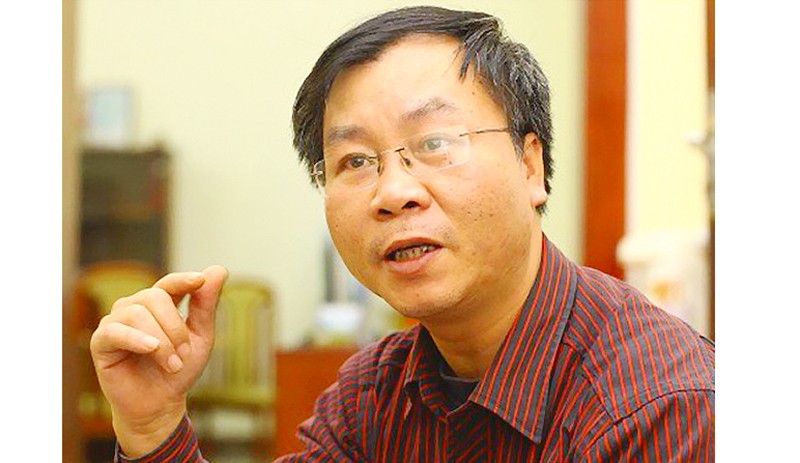 Dr. Vu Dinh Anh. (Photo: SGGP)
Dr. Vu Dinh Anh. (Photo: SGGP)
A project prioritized for investment must first be included in the master plan. Secondly, it must determine the source of capital. If the investment is from the State budget, the capital source must be arranged, and if the investment is in the form of a public-private partnership (PPP), it must have an investor. Right in the planning, the planners have determined the importance and urgency of the project, preliminary calculation of the total investment, estimated capital sources, the starting and ending time of the project. If the planning is done well with a clear strategic vision and scientifically calculated, suitable for natural and socio-economic conditions, and effectively uses resource factors, it will bring great effectiveness to local and national development. As for traffic projects, recently, the construction and the announcement of the planning and implementation plan have many positive changes, promising to create breakthroughs in transportation infrastructure. However, in the regulations on planning and making projects, the role of people as supervisors and beneficiaries of those projects has not been clearly defined. Projects of international organizations in Vietnam pay great attention to the participation of the people, from project making to the process of implementation, termination, and operation and the accountability of the management agency. They have mechanisms and methods for people to participate in the project, and the project will be adjusted according to the opinion of the majority of people. In Vietnam, the projects are still decided by the management agency, the participation of the people is quite limited.



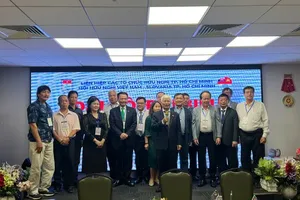

)
